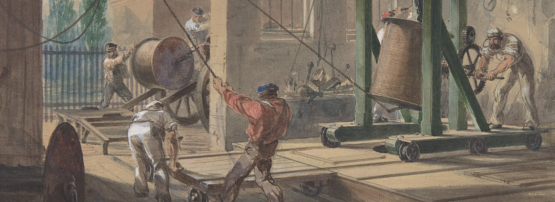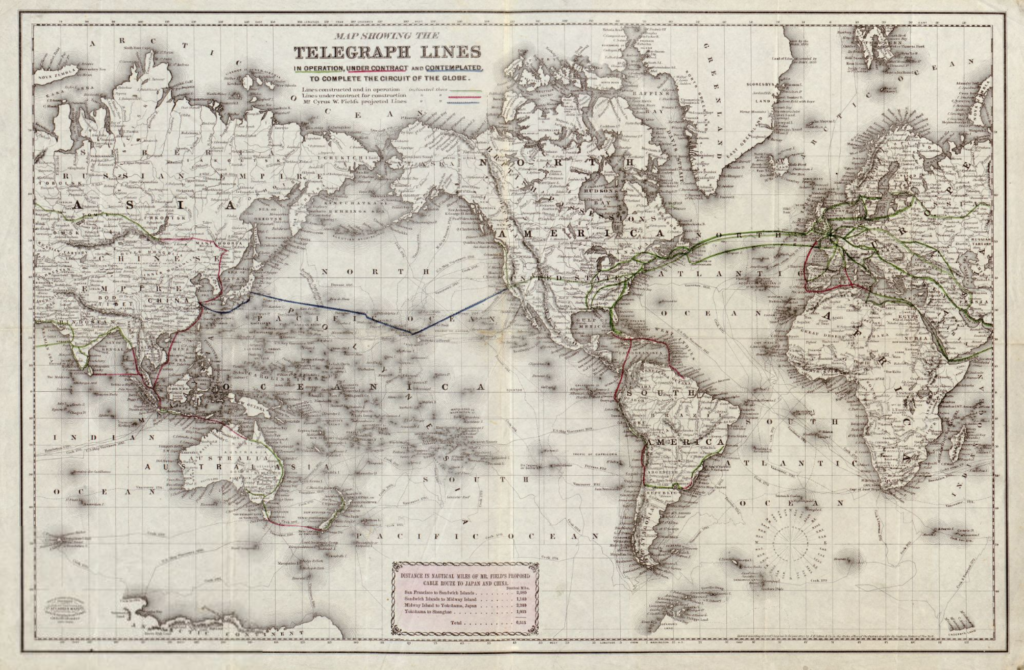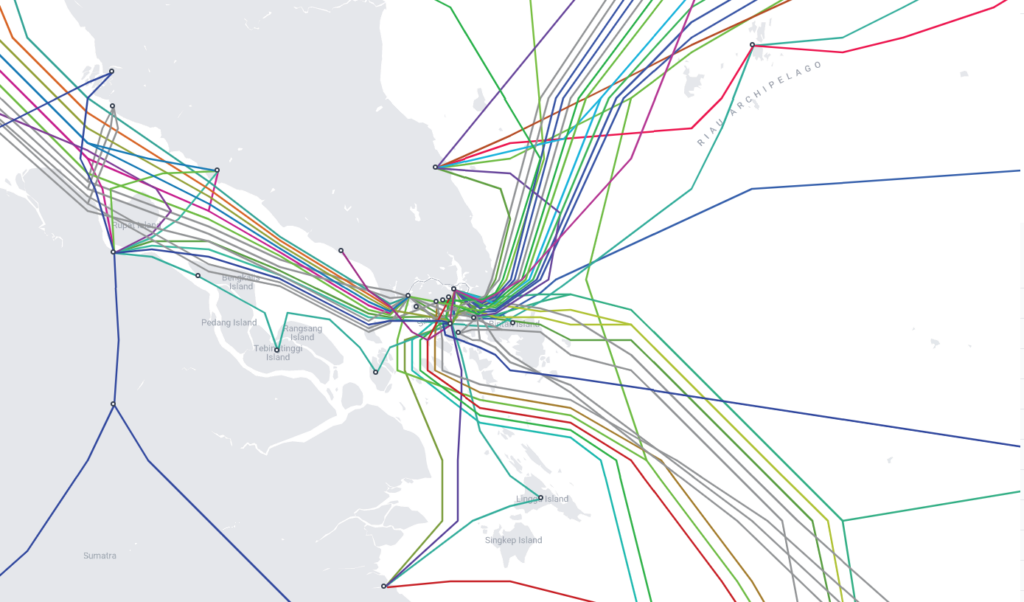
Singapore is an island state in South East Asia with a population just shy of five and a half million, surrounded by significantly larger economies both in terms of geographical size and population, as well as GDP. Unlike its neighbours, it lacks oil and other mineral resources, and its size puts a natural limit on its agricultural output.
In many parts of the world, this wouldn’t be an ideal position for an economy to be noticed on the map, let alone over the long term. Not so for Singapore, the host city of APNIC 54, which since colonial times has not only been an important trading centre and port but has also managed to maintain its pivotal role in the communications world linking South East Asia and the rest of the world.
Connecting the world by telegraph
For well over a century, the time frames of communication between Europe, North America, and the Asia Pacific region were the same as travel between these regions — letter and dispatches literally had to travel physically by ship, coach, and (later) train, with only modest gains made by the overland telegraph systems that began to spring up in the mid-1800s, such as the trans-India telegraph in 1854 and the first transcontinental telegraph across North America in 1861.
From then on, time frames diverged rapidly as submarine cables started to span oceans: 1866 saw the deployment of the first usable transatlantic cable. The first cable in 1859 lasted only a few days following an ill-conceived attempt to unblock its resistance by applying extra voltage. As the low pass filter characteristics of long electrical cables were badly understood then, communication was so slow that the cable’s total traffic over its entire life amounted to only 4,359 words.
India could be reached from Europe by an unreliable combination of overland telegraph and subsea cable from the Persian Gulf to Karachi in 1864, and from 1870, by telegraph from Porthcurno in the United Kingdom, with more sections below the waves. In 1871, the telegraph cables from Madras to Singapore went live.
This was Singapore’s inauguration as a cable hub, a role it hasn’t quite relinquished ever since. In the same year, the telegraph line from Singapore branched out to Hong Kong, Saigon (now Ho Chi Minh City), and Darwin, from where it was linked to the Australian domestic telegraph network in 1872. Four years later, the Tasman Sea was bridged with a cable between Sydney and Wakapuaka near Nelson in New Zealand.
Hawaii, Fiji, and a few other select Pacific Islands got connected early in the century by cable as the Pacific as such was traversed in hops to Manila from California. Similarly, German cables from Manado in North Eastern Sulawesi to Yap, Shanghai, and Guam appeared in 1906. By then, well over 300,000km of submarine telegraph cable had been laid around the world. But most Pacific Islands had to wait until well into the 20th century for real-time communication via radio, and for many, there is still no cable to this day — telegraph or otherwise.
Singapore’s other contribution: Gutta-percha
None of this rapid expansion of the telegraph system would have been possible had submarine cable technology not been able to profit from a major development on the materials science front. Underwater cables carrying electrical signals need to keep water out, and the materials of the early 19th century were not up to the task. As a result, cable lifespan in the harsh ocean environment tended to be short.
A Scottish surgeon named William Montgomerie posted in Singapore by the British East India Company became aware of a local tree gum in the 1940s — the gutta-percha — whose potential for medical use he recognized.
His efforts to socialize the new material in scientific circles were wildly successful. In 1847, Carl Wilhelm Siemens, brother of the founder of the corporation of the same name, laid the first gutta-percha insulated cable through the Rhine River at Cologne. His family was deeply involved in the international telegraph line construction business, and, within a short period, gutta-percha became the insulation of choice for submarine cables. In fact, it was the only choice at the time.
The material became so important that cable companies even incorporated it into their name. Singapore became the hub of the gutta-percha trade, with most of the bulk supply sourced from Malaya and Indonesia.

What was great news for the international communication network was extremely bad news for the tree itself, however. A mature gutta-percha tree — at least 30-years-old and around 10 metric tons in weight — yielded only a mere 300 grams or so of gum. But the industry needed thousands of tons, not just grams, and of course, there were other uses for gutta-percha, from golf balls to truncheons.
Estimates suggest that over 100 million trees were subsequently felled until the tree went virtually extinct in the wild. Montgomerie had warned of this the moment he realized there would be substantial demand. He suggested the trees be planted and tapped instead of felled, but he was mostly ignored. The practice of felling gutta-percha to harvest gum did not stop until synthetic materials became available in the 1930s. Plantings that began when the tree was nearly gone soon became surplus to requirements.
Fast forward
Submarine communication cables are key infrastructure assets — in today’s Internet world even more so than in the days of Morse code and gutta-percha. Teletype and telephone soon started displacing the telegraph, and demand for cable capacity grew. A few decades ago, the type of fibre optic submarine cable that underpins today’s global Internet started appearing on the scene, bringing with it the promise of bandwidth to boot.
Yet, the critical nature of cable assets still means that the choice of cable route and landing points needs to be carefully considered. Nobody wants to put their communications into the hands or through the territory of parties they don’t trust, a consideration that is in good parts responsible for the network topologies we see in the world today. Being a cable hub in this world is, therefore, a significant expression of trust in the stability of the host economy, both in the political and geological sense.

At the time of writing, Telegeography’s Submarine Cable Map showed Singapore serving as the landing spot for no fewer than 25 cable systems, with another dozen anticipated over the next three years or so. Note that some of these cable systems land more than one cable as they use Singapore as a transit rather than an endpoint. That’s more than some larger and far more populous developed economies, and a whopping endorsement for Singapore.
While in Singapore for APNIC 54, you might want to visit its Botanic Gardens and have a look at the tree that shrunk the world.
Dr Ulrich Speidel is a senior lecturer in Computer Science at the University of Auckland with research interests in fundamental and applied problems in data communications, information theory, signal processing and information measurement. The APNIC Foundation supported his research through its ISIF Asia grants.
The views expressed by the authors of this blog are their own and do not necessarily reflect the views of APNIC. Please note a Code of Conduct applies to this blog.
